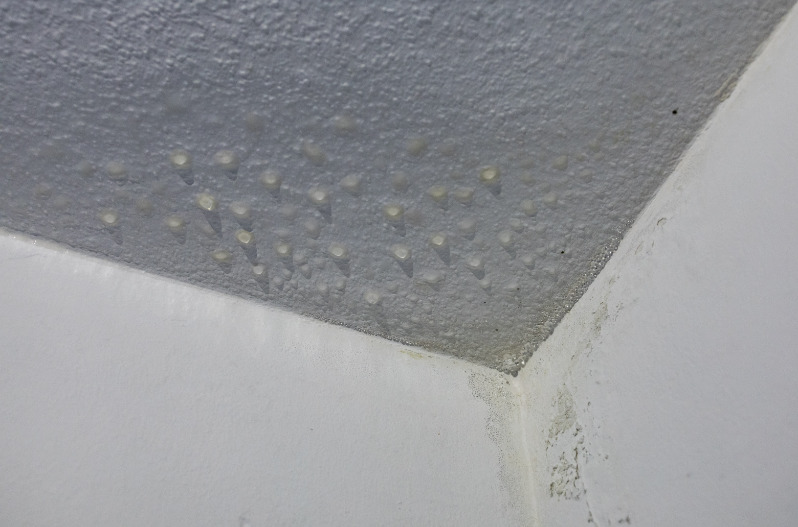Do you have yellow stains on your ceiling? While less dangerous than a ceiling leak, moisture condensation stains can still lead to peeling paint, rotting wood, or even mold. We explain how to clean up ceiling condensation stains. Plus, we look at what causes moisture condensation stains on the ceiling and how to tell them apart from ceiling leaks.
What Are Ceiling Condensation Stains?
Ceiling condensation stains are yellow or brown stains that form when you have excess moisture in your home. Although they can appear in any room, they usually occur in kitchens and baths where steam is common.
Yellow condensation stains on the ceiling typically start in the corner of the room and slowly grow outward. Condensation stains often look blotchy or even look like droplets of water.
Aside from yellow stains, ceiling condensation will cause the paint to peel. The drywall will crack and crumble as the water soaks into the ceiling. The water can lead to mold as well.
What Causes Moisture Condensation Stains on Your Ceiling?
Warm, steamy air is the primary cause of condensation stains on the ceiling. The moisture in the warm air condenses on the colder ceiling surface.
Hot showers and cooking in the kitchen are the main sources of steamy air. However, any source of moisture or humidity can cause condensation stains under the right conditions.
Yellow ceiling stains will appear in as little as a few weeks. Over time, it will soak into the ceiling and cause more damage. Unless you address the problem, it can actually ruin your ceiling.
How Are Yellow Condensation Stains Different From Ceiling Water Leaks?
Since they both leave yellow stains on your ceiling, it’s hard to tell condensation stains and water leaks apart. The primary difference is the source of the water.
With ceiling condensation stains, the moisture originates inside the room. Steam, humidity, or some other source of moisture from in your home condenses on your ceiling.
However, the water soaks through your ceiling into your room with ceiling leaks. An exterior water source like rain leaking through your roof is usually the cause. However, plumbing leaks inside your walls or ceiling are also possible.
Another way to tell the difference between condensation stains and water leaks is whether you can see water on the ceiling. In the case of moisture condensation stains, drops of water will form on the ceiling. However, you usually do not see water with a ceiling leak until it breaks through the drywall.
Signs of Condensation Stains:
- Usually found in the kitchen, bathroom, or laundry room
- Caused by water condensation from inside the room
- Usually can see droplets or beads of water on the ceiling
- The ceiling feels wet and slippery to the touch
- Most common after a hot shower or when boiling water
Signs of Ceiling Leaks:
- Usually found near exterior walls or underneath the roof
- Cause by water leaks from outside the room
- Usually cannot see water droplets on the ceiling
- The ceiling feels damp, but not wet to the touch
- Most common after rain showers or snow melt
- What You Can Do About Moisture Condensation Stains on the Ceiling
What You Can Do About Moisture Condensation Stains on the Ceiling
Address Your Condensation Problem
The only way to fix ceiling condensation stains is to address your moisture problem. Typically this means improving ventilation and removing excess condensation from the air. Unless you fix the problem, the yellow condensation stains will eventually return.
Dry the Ceiling
Start by wiping excess condensation off your ceiling with a towel. Then use a high-velocity fan to dry the area. Since condensation will eventually soak into your ceiling, let the fans run until it is entirely dry. Check the area with a moisture meter every two hours until you get a consistent reading three times in a row.
Clean the Area With Bleach
Once the ceiling is dry, clean it with bleach. Mix one cup of bleach into a gallon of water and wipe down the ceiling and walls to kill mold and bacteria. Let the bleach air dry before moving on to the next step.
Seal the Ceiling With a Stain Blocking Primer
Then seal your ceiling with a stain-blocking primer. Ideally, use a primer meant for kitchens and bathrooms. Not only will it block the stains, but it stands up to moisture better. Follow the instructions for your primer and allow it to dry completely before applying your top coat of paint.
Paint Your Ceiling
Finally, paint your ceiling with at least one layer of top coat. Satin or semi-gloss paint are great at repelling moisture in bathrooms and kitchens. Special bathroom paints with antimicrobial additives and a washable finish are also available.
Are water leaks ruining your ceiling? Call 888-443-3110 now to get a fast, free quote from a local water restoration specialist near you.





